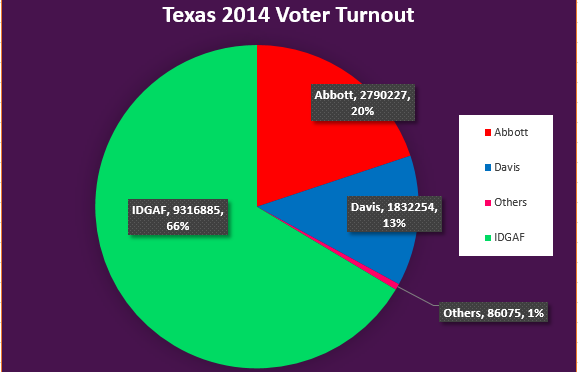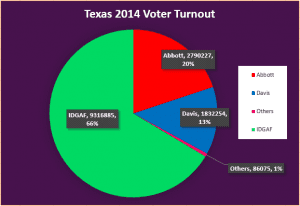#TurnOutForWHAT???
Literally, that is the question on minds all across the nation right now.
With 2014 in the books it’s time to take a look at what happened to Democrats this go round. Why were the results so drastically different than the last two Presidential elections? Despite the efforts of groups like Battleground Texas, it seems that the Republicans had little to no competition in the end. But what also needs to be said is that the so-called “Red Wave” of 2014 shares some similarities with its predecessor in 2010. Here’s what Talking Points Memo had to say about the results…
Older voters helped propel Republicans to sweeping victories Tuesday in Senate and gubernatorial races nationwide, according to exit polls from NBC News.
The disparity between the under-30 and over-60 was the widest it’s been in a decade, those polls found. The seniors comprised 37 percent of the electorate; young people made up 12 percent.
That was even more extreme than 2010, another great Republican year, when the split was 32 percent over 60 and 12 percent under 30.
As we know, an older electorate is more likely to be a Conservative electorate. But what else was very true about voters this week was that there were simply fewer of them that showed up to the polls. In fact, fewer voters showed up than anyone previously thought possible in the state of Texas… over 200,000 fewer than the pathetic voter participation rates of 2010. When you include all registered voters, a full 66 percent of people sat out on this election. Greg Abbott was elected with 20 percent of the actual voter population, Wendy garnered 13 percent, and the rest, well they D.G.A.F…
Yes, I know it’s not a phrase you often find in what one considers “serious” political writing, but is there truly a better descriptor for what happened on Tuesday? The vast majority of Texans Didn’t Give A ____ about the future of our state. And if they did, they still did not care enough to go out of their way and participate in a most critical decision. In other words, a decisive majority of voting-age Texans did not vote at all.
This post is not meant to sound bitter about the current historic levels of voter apathy in the Lone Star State. But at the same time, it is no longer acceptable to keep waging these issues in such polite and non-provocative terms. We want our voters to care enough about who leads Texas through the next four years, and into the next decade. This is important.
And as one would guess, the 2014 electorate will probably reveal a less diverse group of Texans who showed up to the polls. There are no official numbers yet, but one need only look at Harris County Early Voting totals to see that the practice was low in many minority EV locations.
So there you have it. The state’s race for Governor was decided by a puny minority of the state. And yet the political pundits have to use the decisions made from these voters as some validation that Texas is and will forever be a Red State? Some blogs, like Texpatriate are fully convinced of this. But given just how large the IDGAF majority is in the above chart, it’s just impossible to say for certain what this state will do in future election cycles. When you start reading all these articles about the impressive Republican ground game, don’t take it as the gospel truth of the situation.
Personally, I happen to be a voter, a racial minority, relatively young, and someone who used to not GAF about voting or politics. This Silent Majority can be moved if they are empowered by the right set of opportunities. Let’s use 2014 as a teaching tool, and get back to work.

